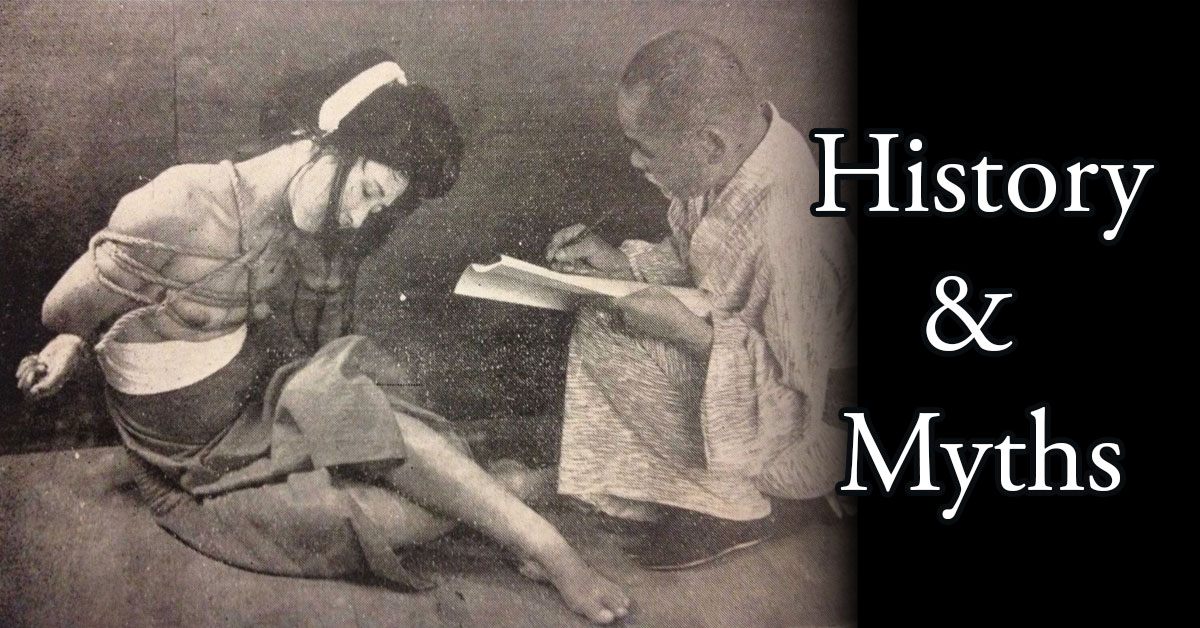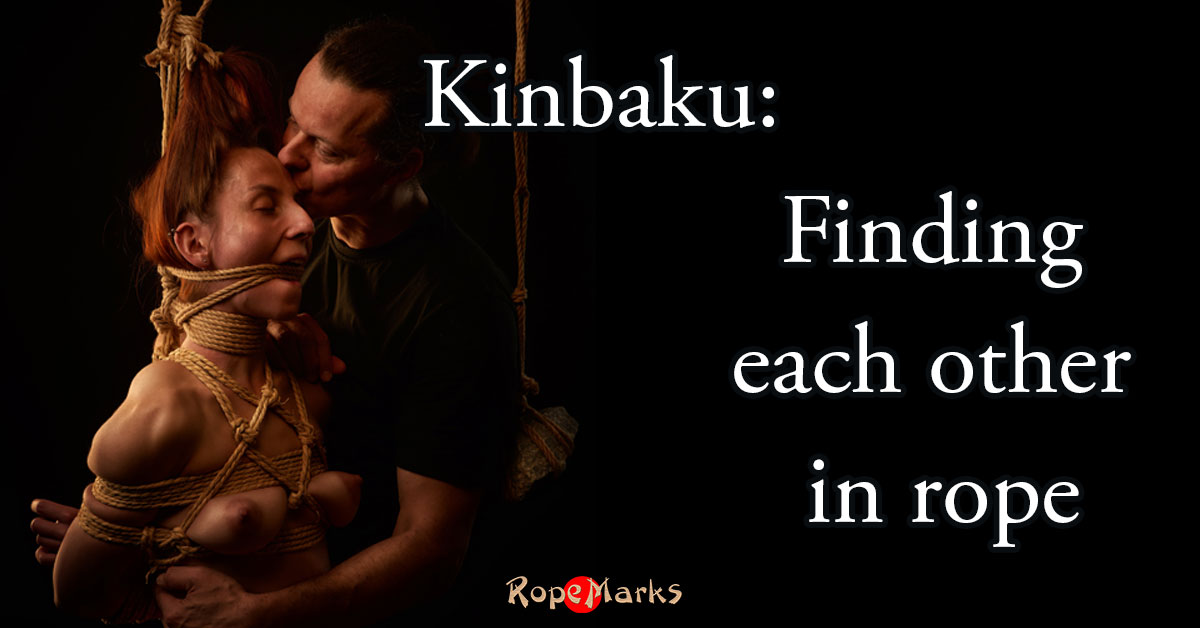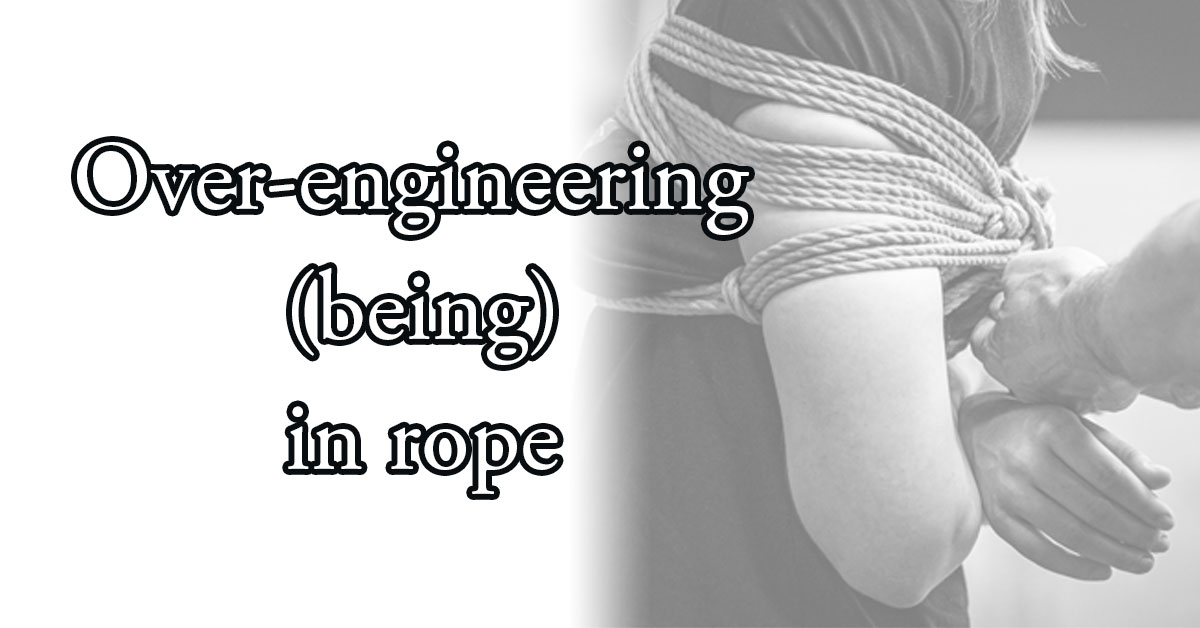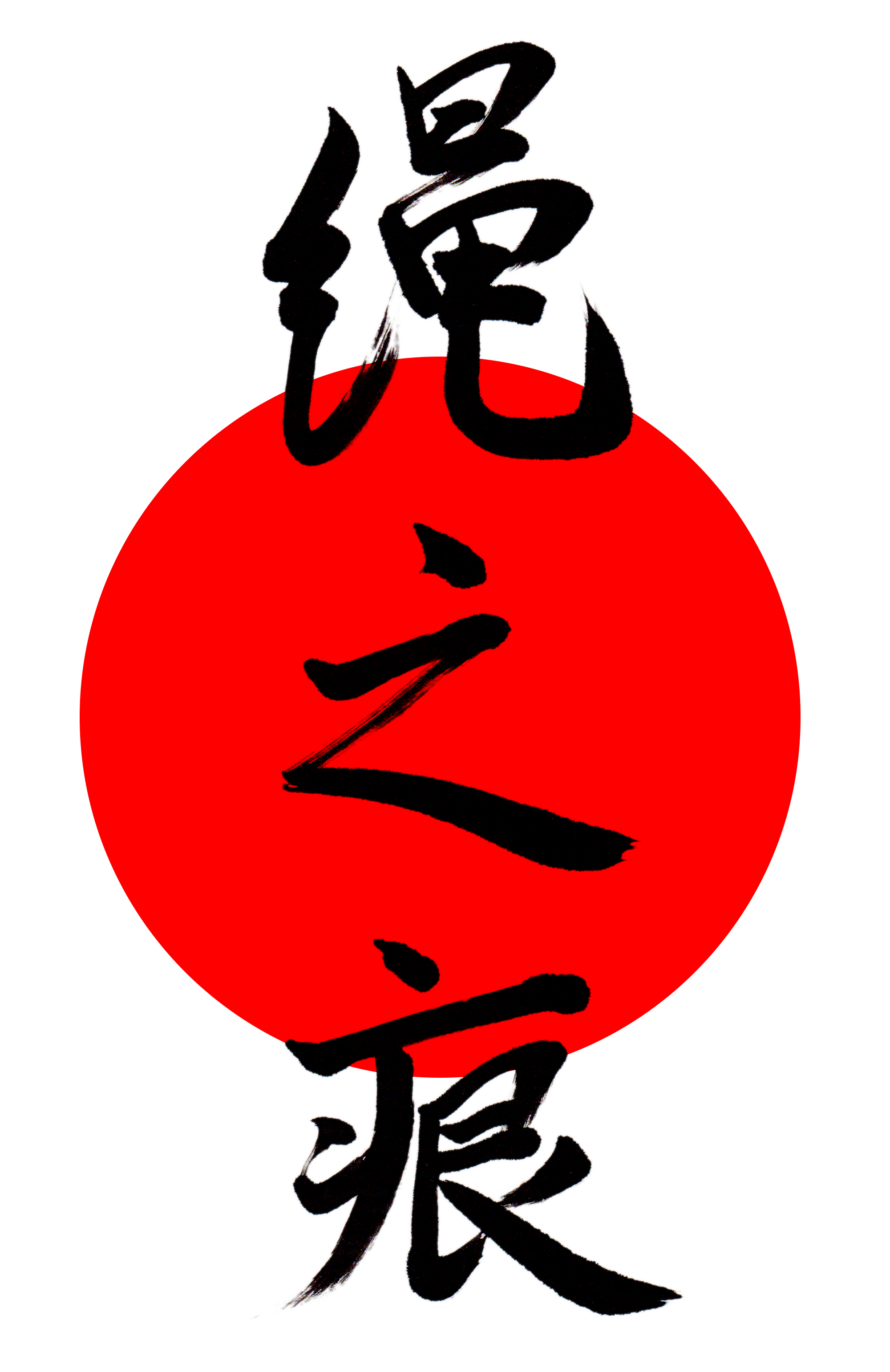In my continues improvement of trying to understand what it is that I do and like I came across an article from Midori. Her article resonated extremely well with me, for one that it puts Japanese bondage (kinbaku, shibari) in a realistic context. It’s an approach that I support and follow. Without further ado, Midori’s wonderful article:
https://spectrumboutique.com/journal/article/the-history-myths-of-japanese-bondage/
Since the internet can have the tendency to be volatile I’ve added Midori’s article below for preservation.
The History & Myths of Japanese Bondage
Censorship, Sex Work, and Othering in the World of Shibari
WRITTEN BY MIDORI
There is a narrative about the history of shibari, or Japanese rope bondage, that’s gone viral in the past few years. It’s very romantic and alluring, and often gorgeously storied. In hushed tones or awed voices, it’s told over and over in shades of variations and languages – in English, German, French, Danish, Swedish, and so many more – except in Japanese. That last part is important.
This exoticized retelling goes something like this…
‘In ancient Japan, noble warriors practiced a secret and/or honorable martial art to respectfully create rank appropriate restraints, or exquisitely arcane torture ties in the field of battle, upon their equally honorable enemies.
Today it’s considered an art form respected in Japan, practiced by wizened old men in dark glasses, masters of this art, upon kimono-clad young women who are naturally submissive and willing. Audiences gather to serenely admire this in tatami matted, austerely beautiful performance spaces. Acolytes practice for years in traditional schools under strict tutelage of these masters for years before they are even allowed to touch rope to nubile flesh…. It is deep and spiritual, as so many things in Japan are, like Zen, like tea ceremonies, like the people and the entire culture.’
Simple linear stories, in easy to find and digest short internet versions in particular give us an immediate sense of cultural competence. But perhaps we feel a tug at the edge of our elation. Is this cultural appropriation?
How glamorous to find one’s pleasure in the direct lineage of noble ancients! How satisfying to celebrate such a refined culture! The allure and urge to romanticize are entirely understandable. How epic! Simple linear stories, in easy to find and digest short internet versions in particular give us an immediate sense of cultural competence. But perhaps we feel a tug at the edge of our elation. Is this cultural appropriation? Is it honoring the art to wear a kimono or insulting it? But, we tell ourselves, we simply adore and cherish Japanese culture through Shibari, so what could possibly be wrong with romancing the rope?
Whether one wears a kimono or not, or knows the right Japanese words for ties or not, is less the issue. At the core of this romance hides something colonial and ugly wrapped carefully fine brocaded silk. It’s about ‘othering’ through exoticizing and flattening cultural and human complexity. The historical and cultural influences that weave together into what we know today as the pleasure craft of Shibari is messy, earthy, often unglamorous, and fascinatingly human.
Let’s put a few, just a few, of the pieces in place.
During the Edo period (1603 to 1863 CE) the Tokugawa shogunate ruled Japan with an iron fist, in tight isolation from the rest of the world. This marked the end of the blood-soaked Warring Era (1467 to 1603 CE), an utterly calamitous time for ordinary folks. It’s akin to the European Middle Ages when the small ruling class had it pretty good but life was miserable for townfolks and serfs. The Sengoku or Warring Nations Era is the period most people refer to when they speak of the martial arts origin story of Shibari. If secret rope fighting skills, practiced by the small handful of people born into the small casts of military leaders 500 years ago, is to make it into general popularity, we’ve got a pretty big leap to make.
Under the strict social control of the Tokugawa feudal government, certain sectors of the economy thrived, bringing power and influence to a newly wealthy mercantile middle class. This booming leisure class sought the pleasures formerly reserved for the nobility, much like the European Renaissance merchants and townies. Overall literacy rose and theaters were accessible and popular entertainment for all. The plays often featured melodramatic plotlines of handsome heroes, clever villains, and pretty ladies, all of whom might find themselves in some story of medieval captivity. This too happened in Europe as we see in the folios of Shakespeare. Unlike Europe where the Age of Enlightenment brought ‘ordinary’ people to question hereditary authority and rise up against them, the Edo government suppressed such pesky wants as liberty and democracy using many effective measures.
Censorship of government criticism and strict laws for the classes and casts were of course in place. But one of the curiously effective strategies of distracting the newly rich from fomenting dissent was establishing and encouraging the pleasure quarters, especially in the economic hub cities. These were walled areas of town with tea houses, theaters, fancy restaurants, inns, music, comedy, and licensed brothels. Not being a Christian-based country, there’s no original sin or guilt of pleasure. Instead, there exists the shame of disharmony or not keeping up one’s social or class responsibilities – Confucian morals, social order, and peer pressure were powerful shapers of behavior.
These pleasure quarters of Edo, with the social attitude around and in them, facilitation of fantasy, and the lives of the workers, is the pre-cursor to the modern-day pleasure quarters in Japan.
The pleasure quarters became the most fashionable and social part of town. Money was spent lavishly and visibly in these quarters in constant search of hedonism and social competition of keeping up with the ‘Jones’ or the ‘Yamadas’, as the case may be here. This is the “Floating World” or the “Ukiyo.” The famous woodblock prints called “Ukiyo-e” comes from this fantasy world. It’s like a little postcard of Las Vegas or Ibiza that anyone could buy and dream of the good life. There were etiquettes of course, as the complicated rules of engagement became part of the social competition. Any peccadillo might be had for anyone of most classes for the right amount of money – even the more peculiar of tastes.
Of course, the life of the workers of the Floating World was rough. Most were some form of indentured servants, spending their life in the walled night city. It still beat starvation in the countryside. This certainly was one of the Tokugawa government’s effective means of civil control. These pleasure quarters of Edo, with the social attitude around and in them, facilitation of fantasy, and the lives of the workers, is the pre-cursor to the modern-day pleasure quarters in Japan.
Here, among the fine restaurants, live music houses, fancy cocktails bars, you’ll also find BDSM themed bars, bondage shows, burlesque theater, swingers clubs, and love hotels. Yes, there are brothels today, but prostitution was criminalized in modern Japan in the 1950’s, due to the moralizing pressure from Europe and the US occupying military forces. Of course, this simply drove direct contact sex work underground, into the opportunistic arms of the Yakuza, the organized crime syndicates of Japan. This included the production and distribution of porn, including rope bondage porn and publications.
As discussed earlier, there’s a high literacy rate in Japan. People read voraciously and small publishing houses have thrived since Edo times and even today. From international mega bestsellers to the smallest of niche interests, This makes it easy for private bondage photo enthusiasts or larger Yakuza owned porn publishers to publish their work… so long as pubic hair or genitalia did not show (another morality law put in place by the occupying American government.)
In the early and mid 20th century there are already several magazines and periodicals around bondage and BDSM in general. Sniper and Kitan Club are two well-known BDSM or bondage magazines of this era. The modern pleasure quarters employ a vast army of the gray economy workers, from the kitchen staff, hosts and hostesses, musicians, janitorial staff, performers, and customer entertainers, to direct service providers.
While sex and sex work isn’t judged harshly as in the US, it’s still not something people openly talk about. The shame is less about the sex of the work, but rather that they failed in attaining the academic exams, school entrance, and employment hurdles that are used to judge a person’s social worth. This too is very Confucian. Many people have quietly had varying degrees of side hustle in the pleasure quarters as the economy wax and wane.
Their ability to perform, sell drinks, charm the customers, give little instructions, sell more drinks, and create an air of exclusivity would elevate that club’s business over the others. It’s an intensely competitive field, especially now that the economy has fizzled since the ’90s and the expense accounts have shrunk.
After World War II the economy was devastated. Many women and men worked for survival, and some were doing kinky performances. The ties were simple though, and not detailed as it has become in the 2000s. In the ’70s and ’80s, Japan’s economy boomed and the salarymen and executives spent lavishly and drank like fish at hostess bars, the modern equivalent of tea houses. Some of these were bondage-themed, offering shows by the staff. These staff were both men and women. Most of the staff tying and being tied were women. Often times a club would have on staff a star male or female performer. Their ability to perform, sell drinks, charm the customers, give little instructions, sell more drinks, and create an air of exclusivity would elevate that club’s business over the others.
It’s an intensely competitive field, especially now that the economy has fizzled since the ’90s and the expense accounts have shrunk. There are more women pro tops than there are male pro tops. But the male workers do receive more gravitas and publication opportunities. There are several reasons for this. As this is an extremely misogynistic culture, the male professionals, even in sex work and teaching rope, are elevated simply for their gender. Second, these images are produced primarily for the male gaze. From a porn producer’s standpoint, the male pro tops are visual proxies for the viewer. This explains the sunglasses clad “ojisan” (older guy) look for many male professionals.
The female pro tops are always decked out in sexy or fetish attire – again, for the consumer the publication targets. If the publications or the bars were the only sources of information, one might assume that only women are tied, and small, young ones at that. One might also assume a particular form or performative flow to be a ritualistic norm in Japan. The reality here is that it’s a stylized performance of the fantasy of bondage for the hetero male consumer, with romanticized nostalgia, where any well-behaved salaryman drinks expensive whiskey and imagines being a wicked warlord having his way with a pretty young thing.
At private gatherings and kinky swingers clubs, the scenery and activities are considerably different than at the bars. People are switching off, they laugh, they fuck, they wear all sorts of fun cosplay outfits or not much at all. The ways that people tie are more fluid and spontaneous. (Still, negotiations, boundary setting, sobriety, and safe words are not the norm in Japan. In this, Americans have led the way in crafting clarity in communication skills. I enjoy teaching bondage and BDSM in Japan because there’s so much of the American skills that they deeply appreciate. These gatherings and even the swingers clubs, however, are often off-limits to foreigners and non-Japanese speakers.)
There’s no expectation of professional mood-setting performance. And photos are strictly forbidden, as the participants are intensely private. These are school teachers and middle managers, they’re factory workers and students, they’re IT workers, and… they are ordinary people finding ways to get their fun freak on. People embrace the tawdriness of it. It’s fun and filthy and lots of people may know something about it, but no one speaks of this in polite company, even if the very same polite company was at the very same bondage bar the night before.
Like graffiti, tattoos, low riders, burlesque, punk clothes, it bubbles up from the impolite populist back alleys, seeping into high fashion or the proper suburbs.
Shibari isn’t considered on par with the tea ceremony. It’s hardly a respected national art form, but it is beautiful naughtiness. It is Japan’s version of lowbrow art. Like graffiti, tattoos, low riders, burlesque, punk clothes, it bubbles up from the impolite populist back alleys, seeping into high fashion or the proper suburbs.
These are just a few threads of the complicated tapestry that is Shibari today. There is more, but this is good enough for today. At the beginning of this article, we read the commonly repeated romantic myth of Shibari. With just a few factors listed above, the whitewashing of human reality is obvious. Humans just want to have fun. The forces that shape our strategies of the pursuit of pleasures are numerous, from wars and occupation, religion, economy, social status, sexism, racism, survival, sex work, etc etc.
The warm gooey source of modern shibari is rooted firmly in the pleasure quarters, sex work, and the erotic strategies of ordinary people. This is rarely spoken of. I suspect that people who come from cultures or backgrounds that are strongly judgmental against sex work may consciously or subconsciously need to distance themselves from the glorious gutter quality of Shibari. Erasing its messy history is erasing the people along with it. Investing in a romantic but false narrative of a culture and its people is another form of “othering”.
“Othering” diminishes, simplifying the inherently complex, to reassure ourselves of simple beliefs and protective biases. We can assure ourselves of the rightness of our actions and our world views. Typically we discuss “othering” as vilification of a group of people. “They’re all lazy.” “Those people are violent.” “You just can’t trust any of them.” etc. It’s not good and we know it.
For all that we do in the pursuit of joy and pleasure, let’s embrace the messy complexity of humanness.
But glorification and adulation is also a form of simplifying and colonizing an idea of a people. It’s another form of admiring “the noble savage”.
Let’s leave the “exotic” to cars or birds.
For all that we do in the pursuit of joy and pleasure, let’s embrace the messy complexity of humanness.
Bonus Section from Midori’s Patreon
A few days ago I was invited to speak on a panel about BDSM and Diversity… with a focus on Shibari today.
Below is what I shared.
Three considerations on Shibari today ~ from Midori
Hello!
Let’s talk briefly about Japanese bondage – or Shibari…
In the ’80s and 90’s, this was the pursuit of a handful of us outside of Japan. Today it’s a hugely popular kink activity. It’s delightful that so many people are adventuring into creative erotic play through this.
The hard work of generations of activists – from Dr. Magnus Hirschfeld, to Dr. Ruth, to Robert Mapplethorpe, to our very own Dr. Carol Queen – to reduce shame and stigma, to bring forth human liberation in sexual expression, is slowly influencing the greater society. This is beautiful.
There are, however, not so delightful facets to the popularity of Shibari today. Something seemingly beautiful is hiding something very ugly – and we’re not talking about it. Or rather, those who do speak out are dismissed or even discredited.
Today let’s focus on just three of some of the problematic aspects of Shibari.
First; the colonized, romanticized story told about Shibari ignored the reality that the images from Japan that inspire so many of us, were and are produced by the adult industry in Japan – by sex workers, for the het male gaze. That these are created as visual or performative erotic entertainment is commonly understood by people in Japan – but taken out of context by those outside of Japan.
It’s a pleasure product created for prurient interests. People in Japan, including those who love it, understand that this is entertainment produced in the margins, by people in the margins – and would consider it silly to equate Shibari to “high cultural arts”. Much like American “low brow” art forms, which can seep into the mainstream from the shunned margins – think of pin-up art and low riders. When it’s incorporated into mainstream art or recognized arts, such as in Araki’s work, it’s the shock of transgressiveness that holds the charge.
Yes, Shibari images are exported from the smut makers.
Second, published and working rope masters, mistresses, performers, and models are part of the larger sex work industries in Japan. To delay this, or to gloss over this, has more to do with the discomfort and bias against sex work of the person denying it.
Third, Japan is a misogynistic and sexist country, where sexual harassment, violence, and women’s disempowerment is normalized. At the same time, men feel disenfranchised after the massive cultural upheaval after World War II. Sexual assault and lack of consent are so common – while reporting and prosecution so rare – when the rapist is convicted it makes national headlines. Then the women are harassed further, often to exile or suicide.
Shibari images from Japan are created in this cultural context. Consent, as we know it, doesn’t happen for women in the photo studios, bondage bars, and rope studios in Japan. This disempowerment is deeply internalized.
Enjoy the imagery while understating the cultural context they were created in.
Again, today we contemplate only three points.
First, that the images and instructions from Japan that thrill us are created in the adult industry for the male gaze.
Second, the creators, teachers, and performers are part of the sex work industry of Japan.
Third, these images and lessons were created in a culture where consent, as we know it, is not the norm – and sexual assault is common.
From these three points, there will be many conversations as we move forward.
Thank you for this opportunity to speak up.
Thank you for hearing me.
With gratitude- in absentia,
Midori
Educator, Coach Sexologist, Artist
Founder: ForteFemme and Rope Dojo
Midori’s Patreon | Contact | Twitter | Instagram | WikiPedia
Workshops | Shop | Club RopeMarks | RopeMarks












Leave A Comment